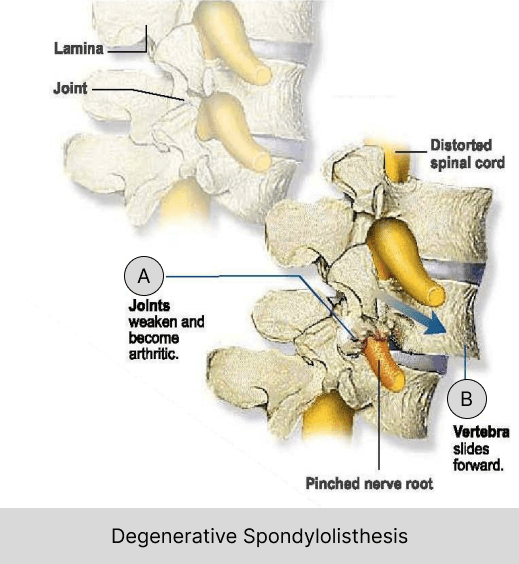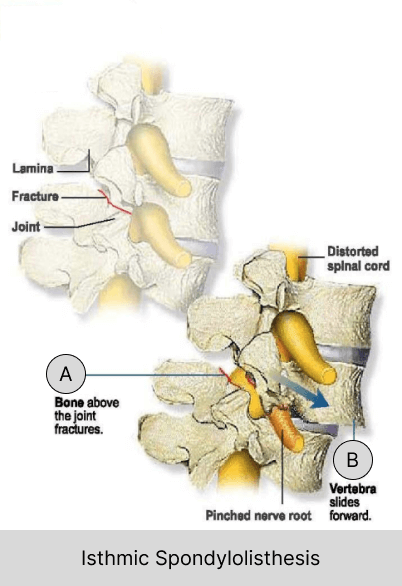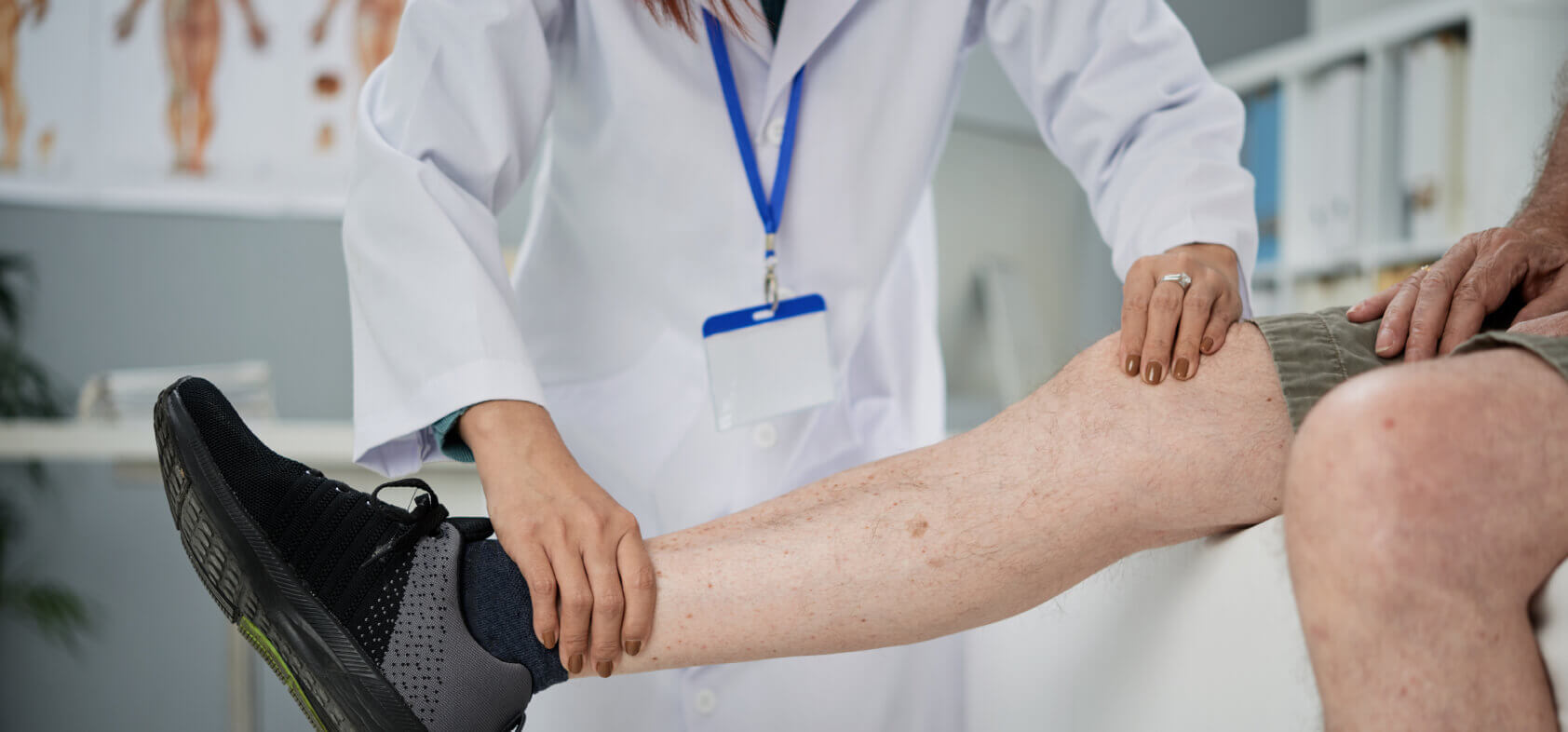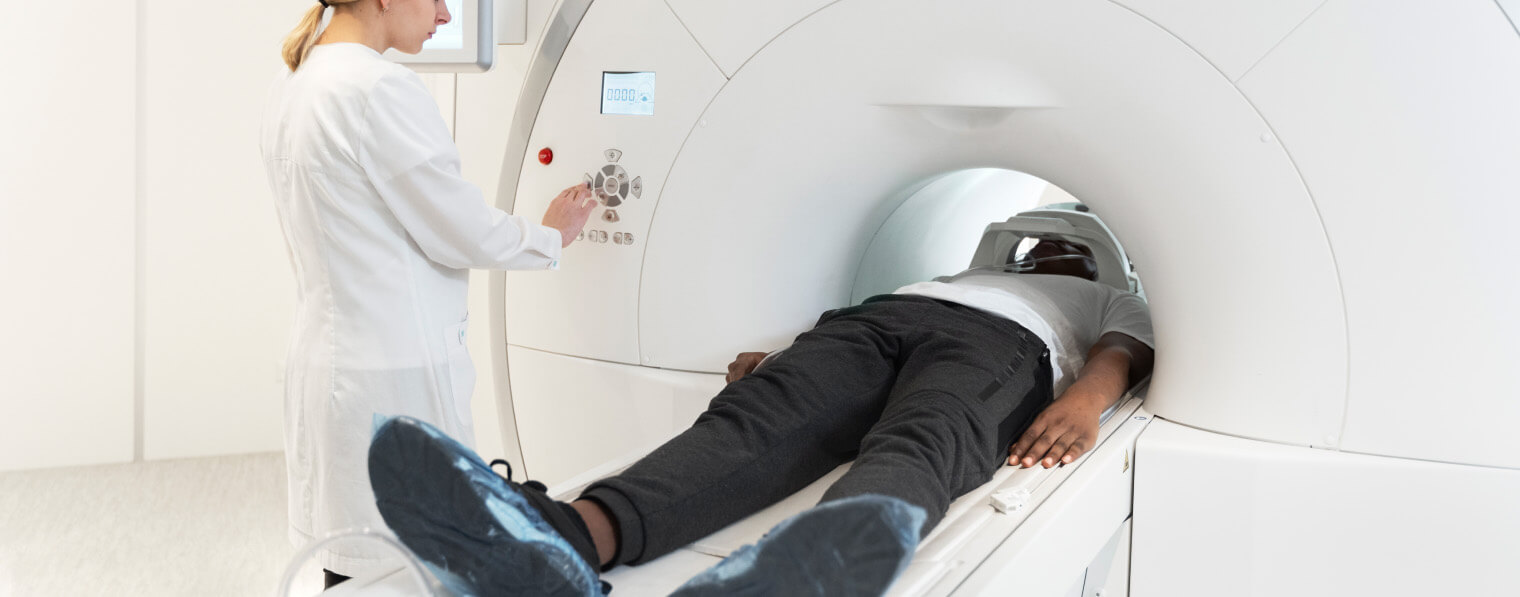What is Spondylolisthesis?
Spondylolisthesis is a Latin word for "slipped vertebral body". Spondylolisthesis is a spinal condition that causes low back pain. It occurs when one of your vertebrae, slips over the vertebra below it.
This displacement can occur in any part of the spine but most commonly affects the lower back, specifically in the lumbar region.
Spondylolisthesis is generally classified into different types based on its cause and severity. The two main types are:
Degenerative Spondylolisthesis:

When the intervertebral discs between the vertebrae degenerate, and the facet joints (the joints that connect the vertebrae) wears down, it is called Degenerative Spondylolisthesis. This type is often seen in older adults.
A degenerative spondylolisthesis generally occurs at one of two levels of the lumbar spine:
The L4-L5 and L3-L4 level.
Degenerative spondylolisthesis is relatively rare at other levels of the spine.
Isthmic Spondylolisthesis:

This type is often seen in younger individuals and is caused by a defect or fracture in a small bone structure called the pars interarticularis, which connects the front and back parts of the vertebra. This condition is most commonly found in the lumbar spine (lower back), particularly in the L5-S1 region, which is the lowest part of the lumbar spine and at the top of the sacrum.
There are other types of spondylolisthesis, but the above two are common. Other types of spondylolisthesis include Congenital spondylolisthesis, traumatic spondylolisthesis, pathological spondylolisthesis, post-surgical spondylolisthesis.
Symptoms
The symptoms of spondylolisthesis vary depending on the severity of the condition. The common symptoms and signs of spondylolisthesis in the lower back are described below:
Low back pain is the most common symptom of spondylolisthesis. The pain is usually described as a dull or a sharp, stabbing pain. The pain may be worse with activity or when bending backward, and in some cases, radiating pain or numbness into the buttocks and legs.
Leg pain while walking. Some people may experience neurogenic claudication, or pain in both legs while walking varying distances.
Muscle Weakness, especially in the lower body. Spondylolisthesis can affect the nerves in the spinal canal, leading to muscle weakness in the legs.
Tightness and Stiffness in the lower back. It can limit the range of motion in a patient.
Difficulty in certain activities like physical activities, including sports and activities that involve bending backward.
Tightness may be felt in the hamstring muscles along with a feeling of weakness or pain.
Understanding the Causes of spondylolisthesis
Spondylolisthesis is influenced by various factors, including genetics, lifestyle and overall spinal health. Some of the causes and risk factors of spondylolisthesis are described below:
Congenital (Present at Birth): Individuals born with a structural predisposition to spondylolisthesis.
Degenerative Changes: The natural aging process can lead to the intervertebral discs degenerating, and facet joints may wear down which can contribute to vertebral slippage.
Trauma: Acute injuries or trauma to the spine, such as fractures or dislocations, can cause spondylolisthesis.
Pregnancy: Pregnancy can lead to hormonal changes and increased mobility of the pelvic joints, potentially increasing the risk of spondylolisthesis in women.
The likelihood of developing spondylolisthesis increases for individuals engaged in gymnastics or football due to the physical stresses associated with these sports. Additionally, if you have congenital thinning of certain vertebrae regions that are susceptible to fractures and slippage, or if you suffer from a degenerative spinal condition, your risk of spondylolisthesis may be elevated.
Diagnosis of Spondylolisthesis
Diagnosing spondylolisthesis is a multi-step process aimed at confirming the presence and severity of the condition while identifying potential underlying causes. Here, we'll delve into the detailed steps involved in diagnosing spondylolisthesis:
Medical History and Physical Examination:
Commencing the diagnostic, your, Spine consultant will conduct a comprehensive review of your medical history. This includes an inquiry into your symptoms, their duration, and any prior spinal injuries or conditions. Subsequently, a physical examination will be performed to examine and assess your spinal mobility, muscle strength, reflexes, and any indications of neurological abnormalities.
Clinical Assessment:
Within the physical examination, your doctor may suggest various clinical tests to evaluate spinal stability and the existence of spondylolisthesis.

Imaging Studies:
To confirm the problem and evaluate its severity, imaging procedures are essential. The primary imaging modalities include:
- X-rays: These provide detailed images of the vertebrae, enabling precise measurement of slippage degree and overall spinal alignment.
- MRI: MRI scans unveil soft tissue anomalies, nerve compression, and other potential spinal conditions accompanying spondylolisthesis.
- CT Scan: CT scans deliver cross-sectional spinal images, aiding in the detection of fractures, and pars interarticularis defects which are very common in isthmic spondylolisthesis, and nerve compression extent.

Neurological Evaluation:
If spondylolisthesis induces neurological symptoms, additional tests like electromyography (EMG) and nerve conduction studies may be conducted. These tests evaluate nerve function, identifying potential damage or compression.
Classification and Grading:
Spondylolisthesis is a systematically classified and graded condition. The Meyerding grading system, widely employed, assigns grades from I to IV, correlating with the percentage of slippage relative to the vertebra below. Grade I corresponds to mild and grade IV indicates severe spondylolisthesis.
Treatment
Preventive measures such as maintaining a healthy lifestyle, engaging in regular physical activity, practicing proper lifting techniques, and seeking prompt medical attention for spinal injuries can help reduce the risk of spondylolisthesis in both men and women. If spondylolisthesis is suspected or diagnosed, appropriate treatment options can be explored, including conservative measures like physical therapy or, in severe cases, surgical intervention to stabilize the spine.
Conservative Treatment:
- Physical Therapy: Exercises to strengthen core muscles and improve posture can help reduce pain and stabilize the spine.
- Pain Management: Over-the-counter pain relievers or prescription medications can alleviate pain and inflammation.
- Lifestyle Modifications: Maintaining a healthy weight and avoiding activities that strain the back can be beneficial.
- Back Bracing: Some patients may benefit from wearing a brace to prevent further slippage.
Epidural Steroid Injections:
In some cases, your spine consultant may recommend injections to reduce inflammation and relieve pain around the affected area.
Surgery:
If conventional treatments don't work or if the condition is severe, surgery may be necessary. Here are the surgical treatments that can be taken into consideration by your spine surgeon:
- Decompression Surgery: Involves removing tissue or bone that's pressing on nerves.
- Fusion Surgery: Connects vertebrae to stabilize the spine and reduce slippage.
Remember, treatment decisions are highly individualized and should be made in consultation with an expert spine consultant. Age, gender, the severity of spondylolisthesis, and individual health factors all play a role in determining the most appropriate treatment approach. The goal is to reduce pain, improve function, and enhance the quality of life for each patient.



